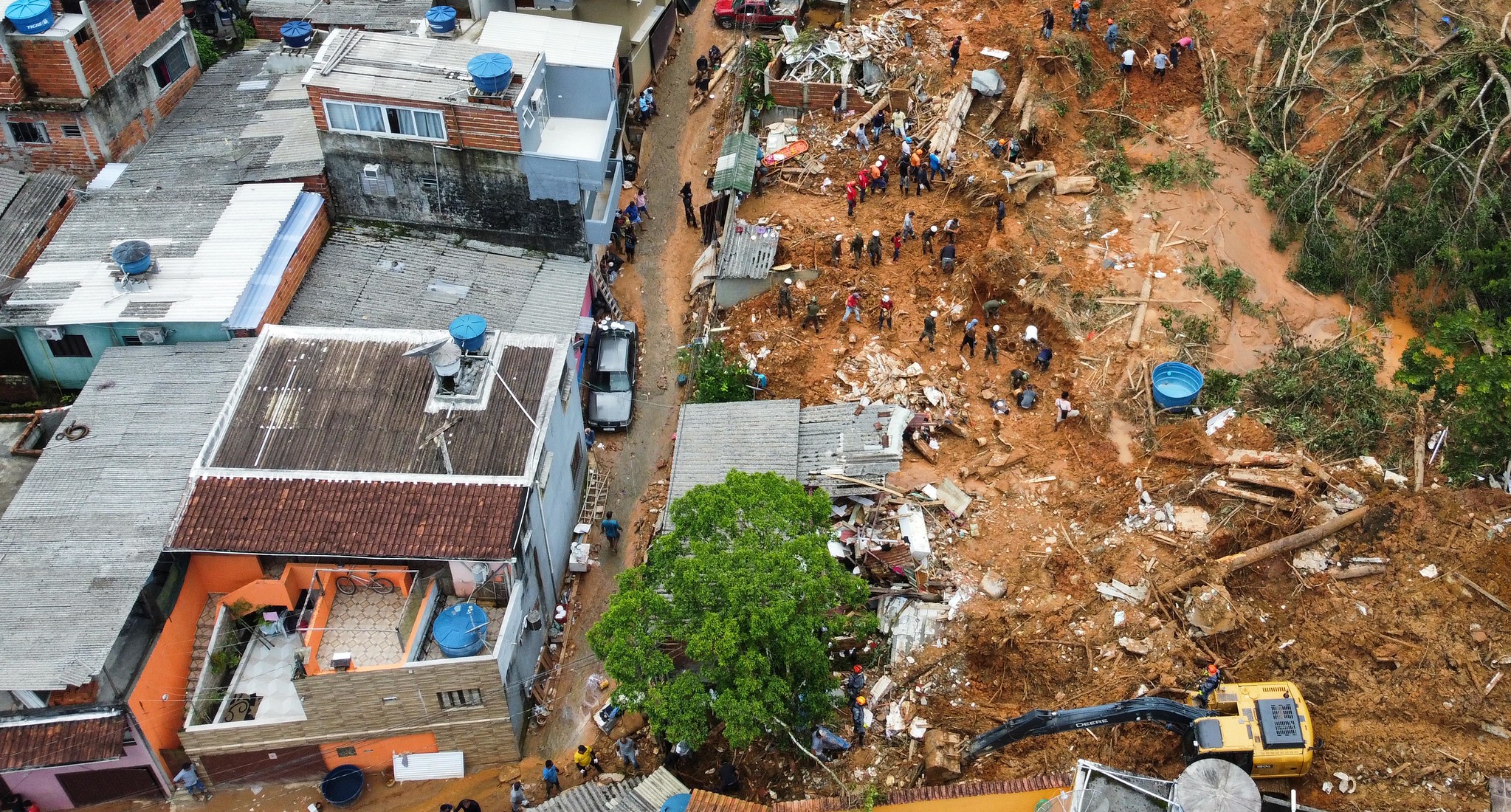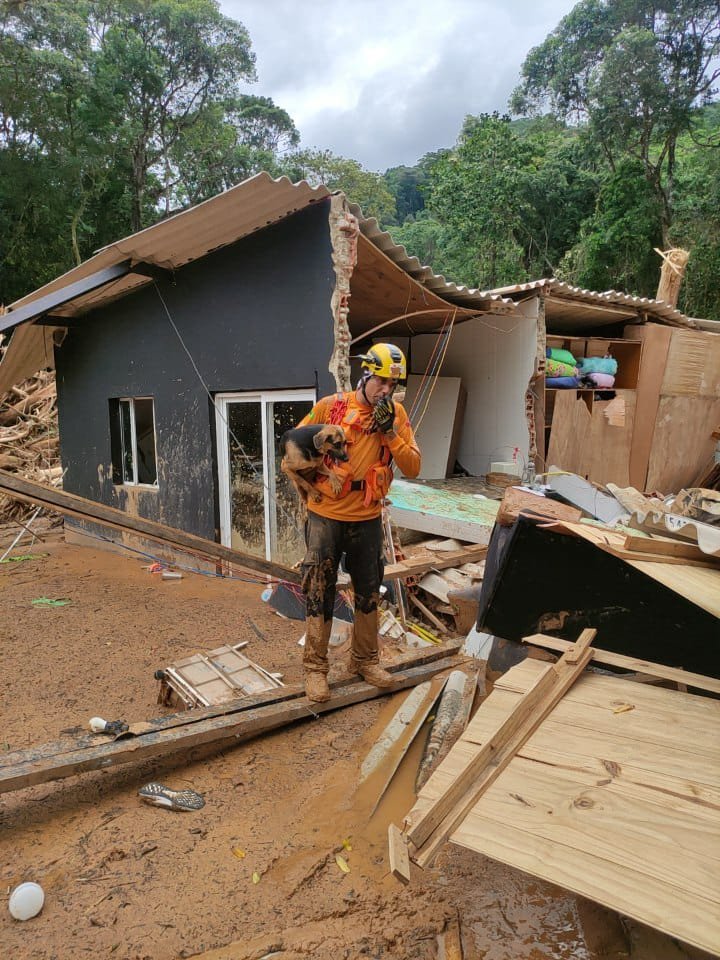
Last updated:
2023 São Paulo, Brazil Floods

Overview
The municipalities of Bertioga, Caraguatatuba, Guarujá, Ilhabela, São Sebastião and Ubatuba in Brazil’s southeastern state of São Paulo received heavy rain on Feb. 19, leading to flooding and landslides.
At least 24 inches (600 millimeters) of rain fell in a single day on the coastal region. Rain continued through the end of the month, hindering search and rescue/recovery and other relief and recovery efforts.
“In a statement of 20 February, Governor Tarcísio de Freitas said that the accumulation of rain in the cities of the North Coast of São Paulo was the highest recorded in Brazil’s history. According to the National Center for Disaster Monitoring Prediction (Cemaden), in 24 hours to 19 February, [26.85 inches] 682 mm of rain fell in Bertioga, [24.65 inches] 626 mm in São Sebastião, [13.27 inches] 337 mm in Ilhabela, [13.19 inches] 335 mm in Ubatuba and [9.21 inches] 234 mm in Caraguatatuba. The previous high was set in 2022 when Petrópolis in Rio de Janeiro state recorded [20.9 inches] 530 mm of rain in 24 hours. The governor said the catastrophe on the north coast is one of the worst incidents of flooding and landslides in the state, and compared the situation to the floods in Guarujá in 2020, and in Itaóca in 2014.”
The disaster struck during Carnival, and many festivities were canceled. Tourists were asked to stay away from “the region in order to avoid overloading hospitals, roads and water and food supply.”
São Paulo Governor Tarcisio de Freitas declared three days of mourning in the state and a 180-day state of calamity for six towns.
Some of the main highways were blocked or even washed away by landslides.
(Photo: Search and rescue efforts on the slope in Barra do Sahy, in São Sebastião following landslides, Feb. 22, 2023. Credit: Government of the State of SP; CC BY 2.0)
Latest Updates

What we’re watching: Weekly disaster update, February 27
Key facts
The official death toll climbed to 65 on Feb. 27, with 64 deaths in São Sebastião and one in Ubatuba. Of these, 57 people had been identified, including 21 men, 17 women and 19 children.
At least 4,000 people had to leave their homes at the height of the disaster, with 3,245 remaining displaced as of Feb. 27. Across the six affected cities, the São Paulo state government reported that as of Feb. 27, 1,346 were homeless. The mayor of São Sebastião said at least 50 homes in his city had collapsed.
On Wednesday, Feb. 22, “a local court granted São Paulo state and the municipality of São Sebastiao permission to force residents from at-risk areas who refuse to move as a last resort, the São Paulo state government said. The floods in coastal São Paulo state were the latest in a series of such disasters to recently strike Brazil, where poor-quality construction, often on hillsides, can have tragic consequences during the country’s rainy season.”
Brazil has a significant social safety network with various nongovernmental and governmental organizations that have responded to the flooding. The area hit by the disaster is the wealthiest state in the country, but that doesn’t mean that all people affected will have their needs met. Philanthropy’s role is to support those that are underserved and under-resourced.
Cash assistance
As with all disasters and large-scale emergencies, donating money to groups already engaged and coordinating on the ground at the disaster site is most effective. They often can take that monetary donation and double or triple the value through local partnerships. In addition, purchasing locally when possible can reinvigorate the economy in the disaster-affected area.
A critical ongoing need will be unrestricted cash donations to support affected families. Direct cash assistance can allow families to secure emergency housing, purchase items and contract services locally that address their multiple needs. It gives each family flexibility and choice, ensuring that support is relevant and timely. Cash assistance can also help move families faster toward rebuilding their lives.
Immediate needs
Those whose homes and businesses have been damaged will need immediate support with temporary shelter and basic household items, food, water, sanitation and hygiene (WASH), mental and physical health services, and restoration of lost livelihoods.
Continued access to education for children and child-friendly spaces, as well as protection of marginalized individuals are also priority concerns.
Long-term needs
In addition to immediate response, long-term recovery needs will include rebuilding and fixing homes, businesses and community infrastructure, economic recovery of local markets, and the replacement of cars and household items.
Brazilian President Luiz Inácio Lula da Silva does not want to have homes rebuilt in the areas at risk for flooding or landslides.

The CDP Global Recovery Fund supported recovery efforts from this disaster.
Contact CDP
Philanthropic contributions
If you have questions or need help with making a donation to the CDP Global Recovery Fund, please contact development.
(Photo: The Group for the Rescue of Animals in Disasters rescuing animals that were trapped in the rubble in São Sebastião after heavy rains that affected the region, Feb. 21, 2023. Source: Government of the State of São Paulo via Twitter)
Recovery updates
If you are a responding NGO or a donor, please send updates on how you are working in this crisis to Tanya Gulliver-Garcia.
We welcome the republication of our content. Please credit the Center for Disaster Philanthropy.
Donor recommendations
If you are a donor looking for recommendations on how to help with disaster recovery, please email Regine A. Webster.
Philanthropic and government support
In June 2023, CDP awarded a $120,416 grant to AVSI (Associação Voluntários Serviço Internacional – Brasil) to support the São Sebastião Together for Recovery and Resilience project. Made in partnership with Google, the grant from the Global Recovery Fund will provide long-term support for families’ (600 people) recovery and increase community resilience after the Sao Paolo floods, including social, economic livelihood and health assistance, and improved living conditions.
According to the government, the São Paulo Social Fund and the Civile Defense Coordination “have sent 112.5 tons of donations to families who lost property” due to the floods and mudslides.
On Feb. 26, the government reported that the São Paulo Secretary of State for the Rights of Persons with Disabilities sent more than 1,500 items to the North Coast, including equipment and accessories for people with disabilities. “There are wheelchairs, bath chairs, wooden and aluminum canes, crutches, fixed knee immobilizers, immobilizing boots, geriatric diapers, tracheal aspiration probes, among others. The products are the result of intense work by the government in partnership with companies and civil society organizations to collect donations for the injured, homeless and displaced.”
The Brazilian Navy’s largest vessel – a multipurpose aircraft ship – arrived in the area on Feb. 23 to help with search and rescue, as well as to serve as an emergency field hospital.
More ways to help
As with most disasters, cash donations are recommended by disaster experts as they allow for on-the-ground agencies to direct funds to the greatest area of need, support economic recovery and ensure donation management does not detract from disaster recovery needs.
CDP has also created a list of suggestions for foundations to consider related to disaster giving. These include:
- Prioritize investments in local organizations: Local humanitarian leaders and organizations play a vital role in providing immediate relief and setting the course for long-term equitable recovery in communities after a disaster or crisis. However, these leaders and organizations are mostly under-resourced and underfunded. Grant to locally-led entities as much as possible. When granting to trusted international partners with deep roots in targeted countries, more consideration should be given to those that empower local and national stakeholders.
- Take the long view: Even while focusing on immediate needs, remember that it will take some time for the full range of needs to emerge. Be patient in planning for disaster funding. Recovery will take a long time and funding will be needed throughout.
- Recognize there are places private philanthropy can help that government agencies might not: Private funders have opportunities to develop innovative solutions to help prevent or mitigate future disasters that the government cannot execute.
- All funders are disaster philanthropists: Even if your organization does not work in a particular geographic area or fund immediate relief efforts, you can look for ways to tie disaster funding into your existing mission. If you focus on education, health, children or vulnerable populations, disasters present prime opportunities for funding.
- Ask the experts: If you are considering supporting an organization that is positioned to work in an affected area, do some research. CDP and InterAction can provide resources and guidance about organizations working in affected communities.